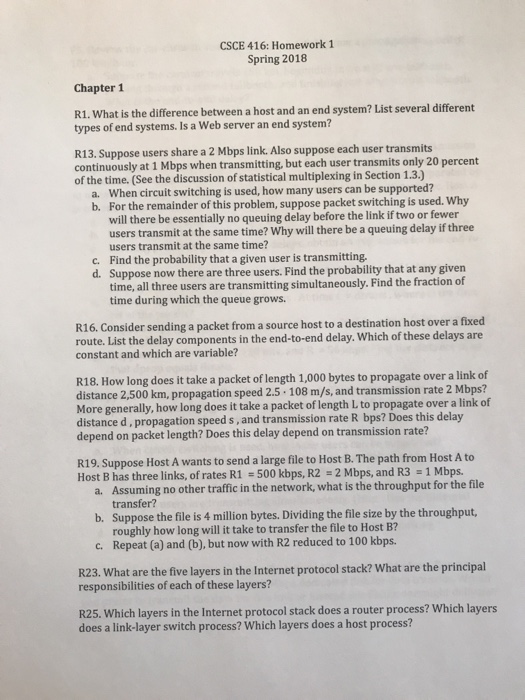CSCE 416: Homework1 Spring 2018 Chapter 1 R1. What is the difference between a host and an end system? List several different types of end systems. Is a Web server an end system? R13. Suppose users share a 2 Mbps link. Also suppose each user transmits continuously at 1 Mbps when transmitting, but each user transmits only 20 percent of the time. (See the discussion of statistical multiplexing in Section 1.3.) When circuit switching is used, how many users can be supported? For the remainder of this problem, suppose packet switching is used. Why will there be essentially no queuing delay before the link if two or fewer users transmit at the same time? Why will there be a queuing delay if three users transmit at the same time? Find the probability that a given user is transmitting. S a. b. c. d. uppose now there are three users. Find the probability that at any given time, all three users are transmitting simultaneously. Find the fraction of time during which the queue grows R16. Consider sending a packet from a source host to a destination host over a fixed route. List the delay components in the end-to-end delay. Which of these delays are constant and which are variable? R18. How long does it take a packet of length 1,000 bytes to propagate over a link of distance 2,500 km, propagation speed 2.5.108 m/s, and transmission rate 2 Mbps? More generally, how long does it take a packet of length L to propagate over a link of distance d, propagation speed s, and transmission rate R bps? Does this delay depend on packet length? Does this delay depend on transmission rate? R19. Suppose Host A wants to send a large file to Host B. The path from Host A to Host B has three links, of rates R1-500 kbps, R2 2 Mbps, and R3-1 Mbps. a. Assuming no other traffic in the network, what is the throughput for the file transfer? Suppose the file is 4 million bytes. Dividing the file size by the throughput, b. roughly how long will it take to transfer the file to Host B? Repeat (a) and (b), but now with R2 reduced to 100 kbps. c. R23. What are the five layers in the Internet protocol stack? What are the principal responsibilities of each of these layers? R25. Which layers in the Internet protocol stack does a router process? Which layers does a link-layer switch process? Which layers does a host process







